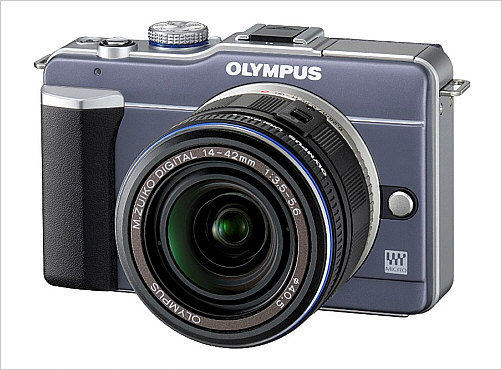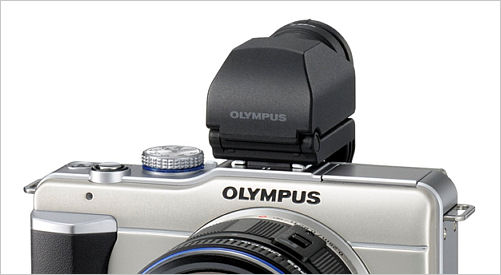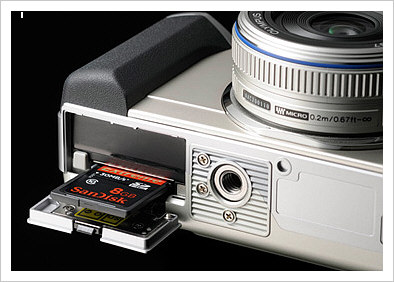

Olympus PEN E-PL1 Review

The Olympus PEN E-PL1 is the third camera in the Olympus PEN series, coming after the E-P1 and E-P2 but before the E-PL2, E-PM1 and E-P3. Confused already? Well here's a quick run down of the various models.
- E-P1 - 06/09 The original Olympus PEN digital mirrorless camera.
- E-P2 - 11/09 An update of the E-P1 which added an electronic accessory port and slightly better AF
- E-PL1 - 02/10 A "lite" version of the E-P2 with somewhat simplified controls and a slightly smaller LCD, but now with a built in flash and a revised TruePix V image processor yielding slightly better image quality. Max shutter speed is 1/2000s (vs 1/4000s for P1 and P2)
- E-PL1s 11/10 Basically identical to the E-PL1 but with a slightly higher capacity battery
- E-PL2 01/11 Upgrade of the E-PL1 adding a rear control wheel and higher resolution LCD
- E-PL3 06/11 Slight physical redesign, plus tilting LCD and updated menu
- E-PM1 06/11 Simplified "P&S" version of the E-PL3 with fixed LCD and no mode control dial
- E-P3 06/11 Current "top of the line" model. Faster AF, higher resolution touch sensitive fixed LCD screen and 1080i60 HD movies in AVCHD format.

One point to note is that all of the Olympus PEN series cameras use the same 12.3MP four-thirds sensor as shown above, and all are capable of delivering essentially the same image quality. The smaller area outlined in yellow is the approximate size of the sensor found in high end compact P&S cameras like the Canon G12 and Nikon P7100.
I bought an Olympus E-PL1 for myself
A lot of the equipment I review here I don't own. It's loaned to me by the manufacturer for the purpose of review. However in a few cases I review equipment that I actually bought for myself. This is such a review.
So why did I chose to buy a MILC camera and why an Olympus E-PL1 rather than one of the other models or some other MILC (mirrorless interchangeable lens camera)? I wanted something easier to carry around than my Canon EOS DSLR outfit for those times when a bag full of gear just isn't approprite, but I also wanted something that would give me better image quality than a compact P&S camera. Why the Olympus E-PL1? Well, three reasons, basically size, cost and flexibility! The size makes it just pocketable (in a jacket pocket) with the 14-43 kit lens attached. Flexibility comes from the fact that adapters to use just about any manual focus lens on the Olympus PEN E-PL1 are available and inexpensive. So for example you can mount older Konica, Nikon, Olympus, Canon FD, Yashica, Leica and Minolta lenses. You can even mount Canon EOS lenses if you want, but there would no no aperture control. When it comes to cost the E-PL1 is an older (but still current) model and now available at a significant discount from its original price (even though it's less than 2 years old) or even in a factory refurbished version from Olympus. It's essentially a 3rd generation model, with better AF then the original EP-1, plus it has a built in flash. It also has a revised low-pass filter and image processor which yield slightly higher resolution images. Overall the E-PL1 at a refurbished price under $300 with the 14-42 kit lens seems like the best bang for the buck in the PEN lineup right now. This is especially true considering that the newer and more expensive models really just add features (better LCD, better ergonomics, higher resolution video) rather than any significant improvement in image quality. Maybe future "E-P4" models will have a new higher resolution sensor, but as I said earlier, all current models use the same 12.3MP sensor (which is also used in the Olympus DSLRs).
You can find a refurbished Olympus E-PL1 with the 14-42/3.5-5.6 zoom lens for under $300 at ADORAMA. Currently the price is $299.95 (with free shipping).
Physical Layout

The top of the Olympus E-PL1 houses the on/off button, the shutter release, the main mode control dial, the hot shoe and the pop-up flash (on the left in the above image). The main mode dial has 8 settings:
- i-auto - Intelligent auto mode. Analyzes image for best "scene" mode
- Program mode - allows more user control than 1-auto
- Aperture priority mode
- Shutter priority mode
- Manual mode
- Movie mode
- Screen - allows user to select from 19 different "screen" modes
- Art - allows the choice of 6 different "art" filters (Pop art, Soft Focus, Grainy Film, Pin Hole, Diorama and Sepia)


Electronic Viewfinder mounted
On the rear of the camera are the LCD, the main control buttons, an electronic connection port for the accessory electronic viewfinder (right below the hot-shoe) and the flash release switch. There is a separate movie record button (which can also be assigned other functions), a display magnify button, The usual 4 way selector buttons which can be used either to navigate menus in menu mode or which bring up menus for control of flash, drive mode, AF zone selection and exposure compensation. The button at the top left (Fn) can be customized by the user in shooting mode (and selects a thumbnail view in playback mode)
Menus and Options
If I had the time and inclination I could probably write 10 pages describing all the menus and options available on the Olympus PEN E-PL1, but that's what the Olympus manual is for! I can say that the menu options are extensive and that there are so many options that it might be confusing for a beginner. Of course you can just set the main mode dial to one of the auto modes and the camera will function perfectly well using all the default setting.
However you can in fact tailor the camera to your exact specifications. For example you can change the color balance and brightness of the LCD display to your liking. You can assign one of a number of functions to the "Fn" button on the rear of the camera and you can reassign the "red dot" button which normally controls movie on/off to another function such as selecting the face detection AF mode, Autoexposure lock, autofocus lock, AF/MF switch for the lens, toggling between shooting JPEG and JPEG+RAW, setting custom white balance etc. It can also be assigned to select "My mode" which stores two sets of user defined operational parameters such as setting for the image stabilizer, flash mode, picture mode,exposure compensation, bracketing, ISO, noise reduction, color space, AF mode, image aspect ration, drive mode and quite a few others.
When it comes to bracketing you can bracket exposure, ISO, white balance and flash exposure. Image stabilization can be set to horizontal stabilization or vertical stabilization (for panning) or stabilization on both axes for normal use. When a lens is used that doesn't communicate its focal length electronically (e.g. a manual focus lens adapted to micro 4/3), you can register the focal length (from 8mm to 1000mm) so that the image stabilization system is optimized for the lens in use.

Super Control Panel display
The only downside of so much flexibility is that it can be quite confusing trying to navigate through all the menus to get at some of the lesser used functions. The menu system isn't exactly "user freindly". Thankfully though, the functions that most photographers will use most (WB, ISO, AF mode, Drive mode, Flash mode, Metering pattern etc.) are all easily accessible. In fact they can be collected into a "super control panel" which is displayed via the "OK" and "Info" buttons. Also, the novice user can just ignore all the customization that's possible and shoot with the Olympus E-PL1 in the default auto modes and still get excellent images.

Flash
The E-PL1 has a built in flash, something lacking in the original E-P1 and E-P2 models. It's not powerful, but better a small flash than no flash at all. The guide number is 10m at ISO 200 and can be used in auto TTL mode or manually fired at full, 1/4, 1/16 or 1/64 power. It can also be used for wireless control of external off-camera Olympus flashes (FL-36R or FL-50R for example). At ISO 200 the range of the flash is about 10ft at f4. so it's fine for portraits but would have difficulty with larger groups unless you are prepared to shoot at high ISO settings. The range at ISO 800 would be 20ft at f4 and the range at ISO 3200 would be 40ft at f4. Flash sync speed is 1/30-1/160 (1/125-1/2000 in super FP mode with external flash). Olympus don't seem to specify the coverage angle, but it's probably designed to cover the angle of view with the 14-42 kit lens at 14mm, which is the same angle of view as a 28mm lens on a full frame DSLR.
Storage
Thankfully Olympus have given up on using their own "Xd picture card" memory cards in their cameras (or at least they have in the PEN series), and the Olympus PEN E-PL1 uses a standard SD/SDHC card. The card slot is on the bottom of the camera as shown above. It's clear that you couldn't swap memory cards with the camera on a tripod, but that's not really much of an issue for most users. For shooting video a class 6 or faster memory card is recommended.
Battery Power
The Olympus Pen E-PL1 uses a BLS-1 rechargeable lithium battery (a charger and battery are supplied with the camera). Olympus estimate around 290 shots per charge with IS turned on and flash used for 50% of the shots (CIPA testing standard). The original Olympus PS-BLS1 battery is rated at 7.2v 1150mAh, but I've seen BLS-1 compatible batteries rated at 1400mAh and even some rated at 1700mAh.
Remote Release
There isn't one. Despite ads which are selling Olympus wired and wireless remotes that they claim are compatible with the Olympus E-PL1, the fact is that none of them will work. The E-PL1 shutter cannot be remotely controlled by any of them. The Olympus remote will plug in, but it will not function. Also lacking is a low light AF assist light. So if remote control and low light AF focusing with an assist light are critical for you, look elsewhere. For example the Olympus E-PL3 does have an AF assist light and is compatible with the Olympus RM-UC1 USB remote release.The Olympus E-PL1 does however have a delayed release timer (2 or 10 seconds) and in fact also has a somewhat hidden "anti vibration" function which allows you to set a delay of between 1/8s and 30 seconds between the time when the shutter closes to cover the sensor and the time when the actual exposure is taken. This is a sort of "mirrorless lock up" function. In a DSLR the mirror moving can induce vibration so can be locked up to prevent this happening. In the Olympus E-PL1 the sensor is normally exposed to give the Live View image on the LCD. When an exposure is taken, the shutter first closes, then it opens and closes again to take the actual shot. The first shutter closing can cause slight vibration, so for critical applications you can specify a time after the shutter initially closes to wait for any vibration to die out before the actual exposure is taken. This can be useful for applications like high power microscopy or astrophotography at high magnification.
Operating Speed
When it comes to operating speed the Olympus PEN E-PL1 is something of a mixed bag. The AF speed isn't blindingly fast, but part of this is due to the slow focusing of the 14-42 kit lens. Typical AF time is just over 1/2 second. This isn't awful and is faster than many P&S cameras, but it's not as quick as most DSLRs or the latest generation of MILC cameras like the Pentax Q and Nikon 1 series.In continuous mode you can shoot the highest quality JPEGs at around 3 frames/sec for something like 15/16 frames after which the rate slows down a little to something like 2 frames/sec. In RAW mode you still get 3 fps, but only for 9/10 frames after which the rate drops to around 1 fps. Shooting RAW + JPEG at 3 fps the buffer fills after 8/9 frames and then shooting slows down to around 1 frame every two seconds.
Shutter lag after prefocusing is very short. I couldn't measure it but I'd estimate it's around the same as a DSLR, which is under 100ms (0.1s).
Image Quality
The image quality of shots taken with the Olympus E-PL1 is very good, approaching that of many DSLRs. In fact it uses the same sensor as the Olympus DSLRs. One reason is that Olympus have a very good JPEG engine which is capable of turning out images as good as those that can often be obtained by shooting RAW and converting to JPEGs in an external program. Of course RAW allows much more flexibility including some degree of exposure correction, but for a straight conversion using the shooting defaults, the Olympus PEN E-PL1 can produce excellent JPEG images.
High ISO noise levels are maybe a little higher than you would see with a current APS-C sensor DSLR like the EOS 7D. Comparing the images I'd say that the noise level of the Olympus E-PL1 at ISO 1600 probably corresponds to that of the EOS 7D at around ISO 3200 so there's maybe a 1 stop difference.
However when compared to a high end P&S camera like the Canon 12G, the Olympus E-PL1 shows a lot less noise and image degradation. At ISO 1600 the E-PL1 shows about the same level of noise as the G12 does at maybe ISO 640. The E-PL1 also has a slightly higher dynamic range than the G12, at least at higher ISO settings. At low ISO (ISO 100) the E-PL1 shows lower dynamic range than you might expect and this apparently comes from the fact that the "native" ISO of the sensor is ISO 200 and ISO 100 is really an "expanded" setting and as such suffers a DR penalty.
Overall I'm quite happy with the Olympus E-PL1 image quality. To see some sample images please take a look at the image samples page.
Goto --> Olympus PEN E-PL1 Images page.
Conclusions
The Olympus Pen cameras are a good compromise between physical size, sensor size, image quality and cost. They are available at the lower end of the price range, have a larger sensor than the Pentax Q or Nikon 1, and they (and their lenses) are physically smaller than APS-C sensor cameras like the Sony NEX series. There's also the added advantage that they can accept just about any manual focus SLR lens ever made via an inexpensive adapter. With the 14-42 kit zoom you can carry the Olympus PEN E-PL1 in a jacket pocket. It's a little bulky, but it does fit (assuming this is an outdoor jacket, not a suit jacket!). With the available 17/2.8 prime lens it would be a little more compact and an easier fit.
The Olympus Pen E-PL1 is available for around the same price as a mid level P&S compact camera (as long as you don't mind buying refurbished) and yet will offer substantially better image quality and the ability to use many different lenses. Right now the Olympus E-PL1 is something of a "best bang for the buck" camera even though it might not be quite on the cutting edge of 4/3 MILC technology. I'm quite happy with the one that I bought.
If you want something equally small but with a few more features (1080 HD video, AF assist light, remote release compatibility, upgraded LCD screen etc.), take a look at the Olympus PEN E-P3 or E-PL3. There's also a new E-PM1, though that's much more of a stripped down entry level model.
